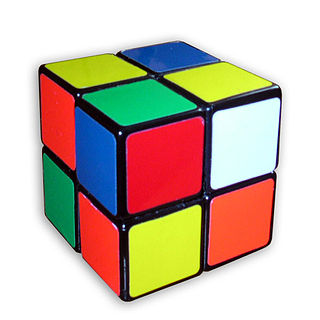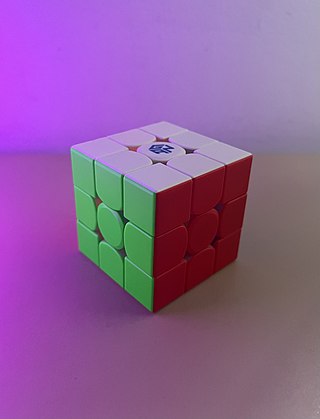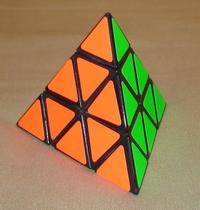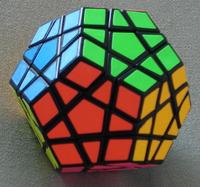
The Rubik's Cube is a 3-D combination puzzle invented in 1974 by Hungarian sculptor and professor of architecture Ernő Rubik. Originally called the Magic Cube, the puzzle was licensed by Rubik to be sold by Pentangle Puzzles in the UK in 1978, and then by Ideal Toy Corp in 1980 via businessman Tibor Laczi and Seven Towns founder Tom Kremer. The cube was released internationally in 1980 and became one of the most recognized icons in popular culture. It won the 1980 German Game of the Year special award for Best Puzzle. As of January 2024, around 500 million cubes had been sold worldwide, making it the world's bestselling puzzle game and bestselling toy. The Rubik's Cube was inducted into the US National Toy Hall of Fame in 2014.

The Rubik's Revenge is a 4×4×4 version of the Rubik's Cube. It was released in 1981. Invented by Péter Sebestény, the cube was nearly called the Sebestény Cube until a somewhat last-minute decision changed the puzzle's name to attract fans of the original Rubik's Cube. Unlike the original puzzle, it has no fixed faces: the center faces are free to move to different positions.

The Pocket Cube is a 2×2×2 combination puzzle invented in 1970 by American puzzle designer Larry D. Nichols. The cube consists of 8 pieces, all corners.

Speedcubing, also referred to as speedsolving, is a competitive sport centered around the rapid solving of various combination puzzles. The most prominent puzzle in this category is the 3x3x3 puzzle, commonly known as the Rubik's Cube. Participants in this sport are known as "speedcubers," who focus specifically on solving these puzzles at high speeds, or more generally as "cubers". The essential aspect of solving these puzzles typically involves executing a series of predefined algorithms in a particular sequence.

The Professor's Cube is a 5×5×5 version of the original Rubik's Cube. It has qualities in common with both the 3×3×3 Rubik's Cube and the 4×4×4 Rubik's Revenge, and solution strategies for both can be applied.

The Pyraminx is a regular tetrahedron puzzle in the style of Rubik's Cube. It was made and patented by Uwe Mèffert after the original 3 layered Rubik's Cube by Ernő Rubik, and introduced by Tomy Toys of Japan in 1981.

The Megaminx or Mégaminx is a dodecahedron-shaped puzzle similar to the Rubik's Cube. It has a total of 50 movable pieces to rearrange, compared to the 20 movable pieces of the Rubik's Cube.
Jessica Fridrich is a professor at Binghamton University, who specializes in data hiding applications in digital imagery. She is also known for documenting and popularizing the CFOP method, one of the most commonly used methods for speedsolving the Rubik's Cube, also known as speedcubing. She is considered one of the pioneers of speedcubing, along with Lars Petrus. Nearly all of the fastest speedcubers have based their methods on Fridrich's, usually referred to as CFOP, that is,.

The World Cube Association (WCA) is the worldwide non-profit organization that regulates and holds competitions for mechanical puzzles that are operated by twisting groups of pieces, commonly known as twisty puzzles. The most famous of those puzzles is the Rubik's Cube. Since the start of the WCA there have been over 10,000 competitions. The WCA was founded by Ron van Bruchem of the Netherlands and Tyson Mao of the United States in 2004. The goal of the World Cube Association is to have "more competitions in more countries with more people and more fun, under fair conditions." In 2017, they started work to become a non-profit organization and on November 20, 2017, the state of California accepted the initial registration of the World Cube Association.
Lars Erik Petrus is an accomplished speedcuber. He has been described as a Rubik's Cube icon and master.
The CFOP method, also known as the Fridrich method, is one of the most commonly used methods in speedsolving a 3×3×3 Rubik's Cube and is one of the fastest methods. This method was first developed in the early 1980s, combining innovations by a number of speed cubers. Jessica Fridrich, a Czech speed cuber and the namesake of the method, is generally credited for popularizing it by publishing it online in 1997.
Leyan Andrew Lo held the world record of 11.13 seconds for the fastest Rubik's Cube solve until Toby Mao in 2006 had a solve of 10.48 at the U.S. nationals competition in San Francisco. Leyan appeared on The Tonight Show with Jay Leno, where he solved a Rubik's Cube in 18.9 seconds. He also holds the former world record for the fastest blindfolded Rubik's Cube solve, at 1:28.82.
Bob Burton is an American speedcuber, most famous for competing in and organizing competitions all over the world and his former world records on the Rubik's Magic and Rubik's Master Magic.

Ron van Bruchem is a Dutch speedcuber living in Hilversum. He helped create the current resurge of Rubik's Cube enthusiasm by founding the international speedcubing community and organizing international competitions. He is also a founder, delegate and former chairman of the World Cube Association, an organization aiming at the spread of speedcubing as a regulated sport. He is also the host of the website speedcubing.com.
Tobias "Toby" Mao is a former world-class Rubik's Cube solver. Hailing from Hillsborough, California, Toby graduated from Crystal Springs Uplands School in 2007 and went on to study mathematics at Northwestern University in Evanston, Illinois. He is the younger brother of Beauty and the Geek second-season participant Tyson Mao, with whom he taught Will Smith to solve a Rubik's Cube for the 2006 film The Pursuit of Happyness. In 2006, Toby set the world record in speedcubing by solving the 3x3x3 cube in 10.48 seconds.

The V-Cube 7 is a combination puzzle in the form of a 7×7×7 cube. The first mass-produced 7×7×7 was invented by Panagiotis Verdes and is produced by the Greek company Verdes Innovations SA. Other such puzzles have since been introduced by a number of Chinese companies, some of which have mechanisms which improve on the original. Like the 5×5×5, the V-Cube 7 has both fixed and movable center facets.
Gilles Roux is a French speedcuber primarily known for inventing a 3x3x3 Rubik's Cube method, the Roux Method, and achieving fast times with it.
The Layer by Layer method, also known as the beginners method, is a method of solving the 3x3x3 Rubik's Cube. Many beginners' methods use this approach, and it also forms the basis of the CFOP speedcubing technique.
Vincent Sheu is an American speedcuber or Rubik's Cube solver from Saratoga, California known for organizing World Cube Association competitions and setting world records in both the Fewest Moves event and the 2x2x2 single solve. He currently serves as a Director and Delegate for the World Cube Association (WCA) and has been an organizer of every annual US Nationals Cubing Competition since 2010. Sheu previously served as the first Chair of the WCA's Regulations Committee with Lucas Garron from 2012 to 2015, directing a complete redrafting of the official competition regulations and guidelines during his tenure. Recently, he has received media attention as the subject of several viral images and video clips at various college sporting events.

The V-Cube 8 is an 8×8×8 version of the Rubik's Cube. Unlike the original puzzle, it has no fixed facets: the center facets are free to move to different positions. The design was covered by Panagiotis Verdes' patent from 2007 but Verdes Innovations SA did not produce it for sale until 2014. Other manufacturers released their own versions of the puzzle much earlier.











